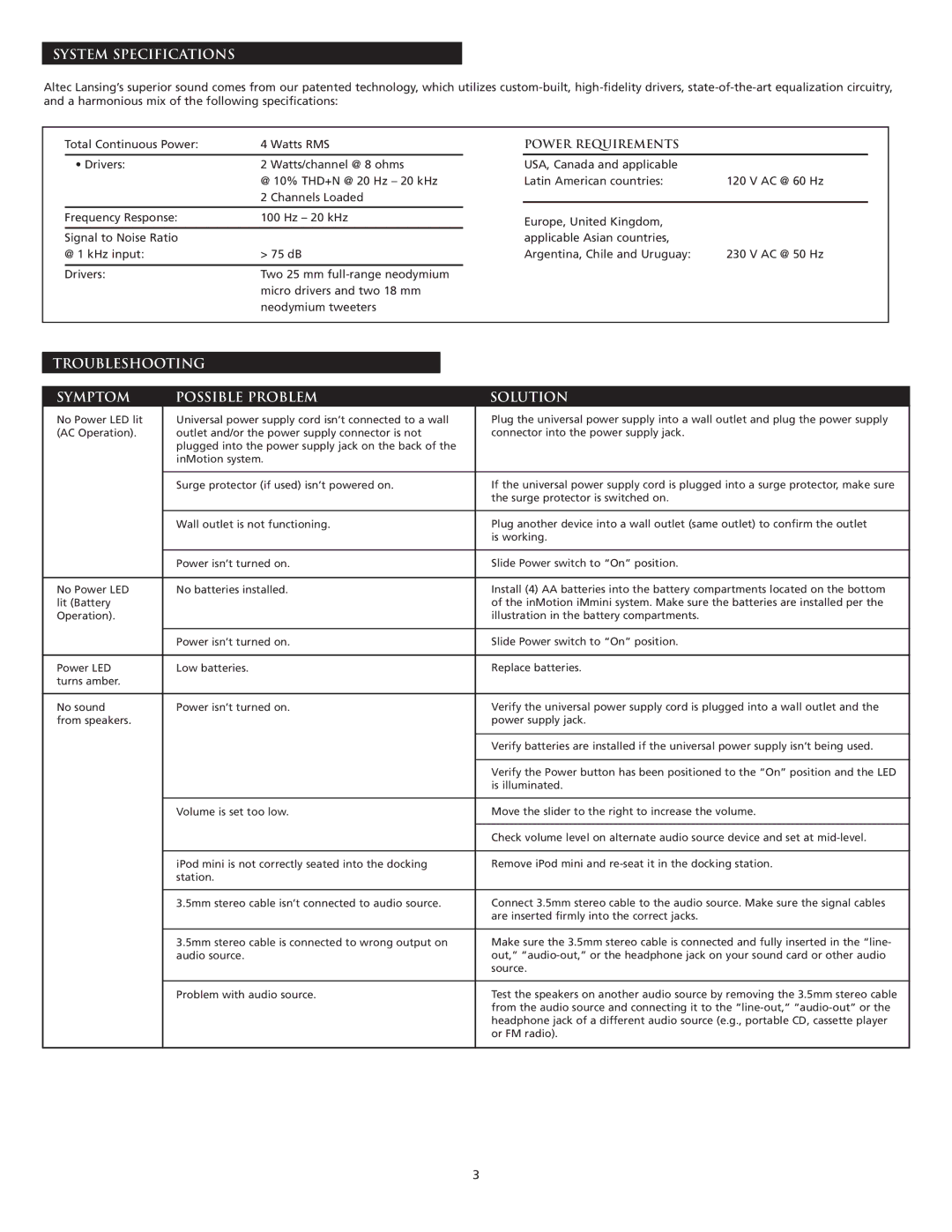
SYSTEM SPECIFICATIONS
Altec Lansing’s superior sound comes from our patented technology, which utilizes
| Total Continuous Power: | 4 | Watts RMS |
| POWER REQUIREMENTS |
|
|
|
|
|
|
|
|
|
|
| • Drivers: | 2 | Watts/channel @ 8 ohms |
| USA, Canada and applicable |
|
|
|
| @ 10% THD+N @ 20 Hz – 20 kHz |
| Latin American countries: | 120 V AC @ 60 Hz | ||
|
| 2 | Channels Loaded |
|
|
|
|
|
|
|
|
|
|
|
|
| Frequency Response: | 100 Hz – 20 kHz |
| Europe, United Kingdom, |
|
| |
|
|
|
|
|
|
| |
| Signal to Noise Ratio |
|
|
| applicable Asian countries, |
|
|
| @ 1 kHz input: | > 75 dB |
| Argentina, Chile and Uruguay: | 230 V AC @ 50 Hz | ||
|
|
|
|
|
|
| |
| Drivers: | Two 25 mm |
|
|
|
| |
|
| micro drivers and two 18 mm |
|
|
|
| |
|
| neodymium tweeters |
|
|
|
| |
|
|
|
|
|
|
|
|
TROUBLESHOOTING
SYMPTOM | POSSIBLE PROBLEM | SOLUTION |
No Power LED lit | Universal power supply cord isn’t connected to a wall | Plug the universal power supply into a wall outlet and plug the power supply |
(AC Operation). | outlet and/or the power supply connector is not | connector into the power supply jack. |
| plugged into the power supply jack on the back of the |
|
| inMotion system. |
|
|
|
|
| Surge protector (if used) isn’t powered on. | If the universal power supply cord is plugged into a surge protector, make sure |
|
| the surge protector is switched on. |
|
|
|
| Wall outlet is not functioning. | Plug another device into a wall outlet (same outlet) to confirm the outlet |
|
| is working. |
|
|
|
| Power isn’t turned on. | Slide Power switch to “On” position. |
|
|
|
No Power LED | No batteries installed. | Install (4) AA batteries into the battery compartments located on the bottom |
lit (Battery |
| of the inMotion iMmini system. Make sure the batteries are installed per the |
Operation). |
| illustration in the battery compartments. |
|
|
|
| Power isn’t turned on. | Slide Power switch to “On” position. |
|
|
|
Power LED | Low batteries. | Replace batteries. |
turns amber. |
|
|
|
|
|
No sound | Power isn’t turned on. | Verify the universal power supply cord is plugged into a wall outlet and the |
from speakers. |
| power supply jack. |
|
|
|
|
| Verify batteries are installed if the universal power supply isn’t being used. |
|
|
|
|
| Verify the Power button has been positioned to the “On” position and the LED |
|
| is illuminated. |
|
|
|
| Volume is set too low. | Move the slider to the right to increase the volume. |
|
|
|
|
| Check volume level on alternate audio source device and set at |
|
|
|
| iPod mini is not correctly seated into the docking | Remove iPod mini and |
| station. |
|
|
|
|
| 3.5mm stereo cable isn’t connected to audio source. | Connect 3.5mm stereo cable to the audio source. Make sure the signal cables |
|
| are inserted firmly into the correct jacks. |
|
|
|
| 3.5mm stereo cable is connected to wrong output on | Make sure the 3.5mm stereo cable is connected and fully inserted in the “line- |
| audio source. | out,” |
|
| source. |
|
|
|
| Problem with audio source. | Test the speakers on another audio source by removing the 3.5mm stereo cable |
|
| from the audio source and connecting it to the |
|
| headphone jack of a different audio source (e.g., portable CD, cassette player |
|
| or FM radio). |
|
|
|
3
